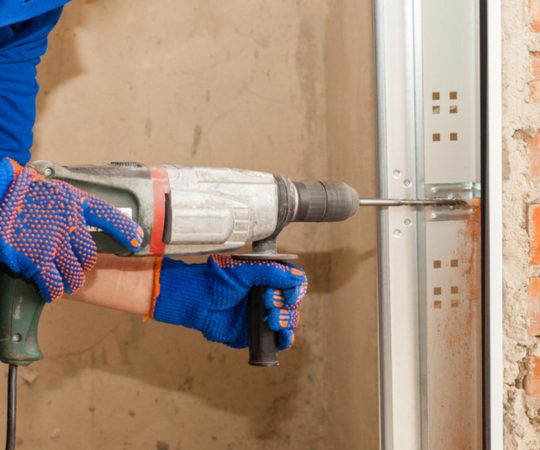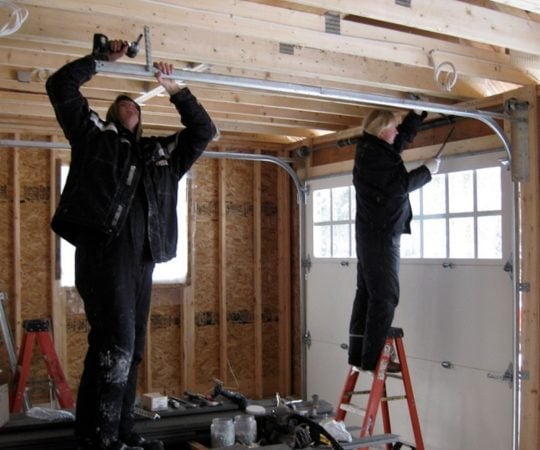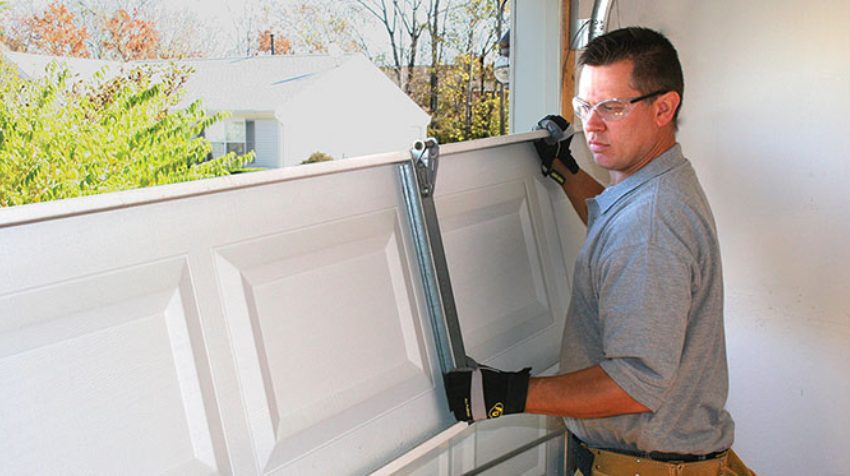Unlocking the Secrets of Residential Garage Door Installation: Your Comprehensive Step-by-Step Guide
Are you tired of looking at that old, rusty garage door every time you pull into your driveway? Do you feel like it’s time to give your home a much-needed facelift? Well, get ready to unveil the magic of residential garage door installation!
In this step-by-step guide, we’ll take you through the process of transforming your outdated garage door into a beautiful and functional addition to your home.
But wait, before we dive in, let’s talk about why this project is so important. Your garage plays a significant role in the overall curb appeal and value of your home. A shabby-looking garage door can detract from the beauty of your property and make it stand out for all the wrong reasons. On the other hand, an attractive and well-functioning garage door can add considerable value to your home while also boosting its visual appeal.
So grab a cup of coffee and get ready to become an expert on residential garage doors – trust us; it’s going to be magical!
Measure Your Garage Space
Before you whip out the measuring tape, take a moment to imagine your empty garage space. Think about how you use it now and how you might use it in the future. Will you be storing vehicles, tools, or sports equipment? Do you need room for a workbench or shelving units? All of these factors will impact your garage door sizing.
Choosing the right material is also crucial. You want something that will hold up against weather and wear and tear but also fits within your budget.
Once you have a clear vision of your garage space and needs, it’s time to measure. Begin by measuring the width and height of your garage opening. Make sure to measure in multiple places as some openings may not be perfectly square or level.
Take note of any obstructions such as pipes or light fixtures that may affect installation. With accurate measurements in hand, you can confidently move on to choosing the right door and opener for your space without any guesswork involved.
Choose the Right Door and Opener
You need to pick the perfect door and opener for your garage, so you can ensure safety, convenience, and style. When it comes to choosing the right door and opener, there are many factors to consider.
First off, think about the style of your home and what type of material would complement it best. There are various styles and materials available such as wood, steel, aluminum, or fiberglass. Each material has its own advantages and disadvantages in terms of durability, maintenance requirements, insulation properties, and cost.
Once you’ve narrowed down your options based on style and material preferences, you can start thinking about cost and budget. Garage doors range from a few hundred dollars to several thousand dollars depending on factors such as size, insulation level, security features, design elements like windows or decorative hardware.
Garage door openers also come with different price points depending on features like horsepower rating (how much power is needed to lift the door), noise levels (belt-driven or chain-driven), remote controls (one-button or multi-button) or smart technology integration with Wi-Fi connectivity. Keep in mind that while investing more upfront may save you money in the long run by avoiding costly repairs or replacements down the line.
To move onto gathering necessary tools and materials for installation process will require some preparation beforehand.

Gather the Necessary Tools and Materials
Now it’s time to get all the tools and materials you’ll need for a smooth installation process. The good news is that most of these items can be found at your local hardware store or home improvement center. Here are some of the tools and materials you’ll need:
- Tools:
- Tape measure
- Level
- Hammer
- Screwdriver
- Drill with bits
- Pliers
- Materials:
- Garage door panels (based on size and material preference)
- Garage door opener (if not installed yet)
- Tracks, rollers, hinges, springs, and cables
- Nails or screws for attaching the tracks to the wall
When it comes to choosing the right materials for your garage door, there are a few things to consider. First off, there are different types of materials available such as wood, steel, aluminum, vinyl or fiberglass. Each material has its own pros and cons in terms of durability, maintenance requirements, insulation properties and cost.
Secondly, you have to decide whether you want to install the garage door yourself or hire a professional installer. DIY installation may seem like a cost-effective option but keep in mind that it requires certain skills and experience as well as special tools which you might not have access to. Hiring a professional ensures proper installation with warranty coverage.
With all your necessary tools and materials gathered together along with an understanding of what type of material will work best for your needs, it’s time now to move onto installing the garage door tracks and hardware so that you can finally enjoy this new addition to your home!
Install the Garage Door Tracks and Hardware
Get ready to tackle the next phase of your garage transformation by effortlessly setting up the tracks and hardware for your brand new door!
The first step in this process is to ensure that the garage door track alignment is correct. Proper alignment is crucial for smooth operation of the door. To do this, use a level to make sure that the tracks are plumb and level.
Next, it’s important to select the proper hardware for your particular garage door installation. This includes hinges, brackets, rollers, and other necessary components. Make sure to choose hardware that’s compatible with both your garage door and your specific track system.
With these steps properly executed, you’ll be able to move on to installing the garage door opener seamlessly!
Install the Garage Door Opener
It’s time to make your life easier and install the garage door opener, so you can effortlessly open and close your new door with just the touch of a button!
Before starting, ensure that your opener is compatible with your garage door. Once confirmed, follow these programming instructions:
- Locate the ‘learn’ button on the opener powerhead.
- Press and release the ‘learn’ button.
- Within 30 seconds, press and hold the button on your remote until lights on the opener flash.
- Test the remote to ensure it’s functioning properly.
Now that your opener is programmed, it’s important to test and maintain it regularly.
Make sure to check for any unusual noises or movements during operation, and lubricate moving parts as needed.
With proper maintenance, you’ll be able to enjoy convenient access to your garage for years to come!
Test and Maintain the Garage Door
Now that you’ve successfully installed your garage door opener, it’s important to regularly test and maintain the door for optimal functionality.
To ensure safety, start by testing the door’s balance and safety features.
Then, lubricate and inspect both the door and opener to prevent wear and tear.
Lastly, be prepared to troubleshoot and repair common issues that may arise over time.
By taking these steps, you can extend the lifespan of your garage door system while keeping it operating safely and smoothly.
Test the Door’s Balance and Safety Features
To make sure the door is safe to use, you should test its balance and safety features by disconnecting the opener and manually lifting the door halfway up. It’s important to take safety precautions during this process – wear gloves and eye protection, keep children and pets away, and avoid standing under the door while it’s being tested.
If it stays in place when lifted halfway up, then the springs are properly balanced; if not, adjustments will need to be made. Testing your garage door’s balance is crucial for ensuring that it operates safely and smoothly. A poorly balanced door can cause damage or injury if it falls unexpectedly or jerks while opening or closing.
In addition to testing the balance, you should also check that all of the safety features are working correctly – for example, sensors that detect obstacles in the path of the door should trigger an immediate reversal of movement. Once you’ve completed these tests, you can move on to lubricating and inspecting both the door and opener components for any signs of wear or damage.
Lubricate and Inspect the Door and Opener
You should lubricate and inspect your garage door and opener to keep them running smoothly and avoid any potential wear or damage. Lubrication is important because it reduces friction, which in turn prevents the parts from wearing down too quickly. You can use a silicone-based spray or white lithium grease to lubricate the metal parts of your door like hinges, rollers, springs, and tracks.
Make sure not to apply too much lubricant as it can attract dirt and debris that may cause more damage. When inspecting your garage door and opener, there are common mistakes you should avoid making. One of these is failing to check for loose bolts or screws on both the door itself and the opener’s motor unit.
Loose hardware can cause the door to come off its tracks or create unnecessary noise during operation. Another mistake is neglecting to test your safety features such as sensors that detect objects in the path of the closing door. By performing regular inspections, you can catch minor issues before they become major problems that require costly repairs.
To troubleshoot and repair common issues with residential garage doors, continue reading below…
Troubleshoot and Repair Common Issues
If your garage door is giving you trouble, don’t worry – we’ve got some tips to help you troubleshoot and fix common issues. Garage door troubleshooting can be intimidating, but with a little knowledge and patience, you can often solve the issue without calling in a professional.
Here are four common garage door issues and how to repair them:
- Door won’t open or close: Check if the opener’s plugged in and if the circuit breaker hasn’t tripped. If that doesn’t work, try reprogramming the remote or resetting the opener’s limit settings.
- Door reverses before fully closing: This could be due to something blocking the sensors or misaligned sensors. Clean them off or adjust their alignment.
- Door makes loud noises: Lubricate all moving parts of the door with silicone spray or lubricant oil.
- Door opens slowly: Check for worn-out springs or tracks that need cleaning.
Another common issue homeowners face is repairing door sensors. These are located near the bottom of each side of the garage door opening and prevent it from closing on someone or something in its path.
If they’re not working properly, first check if they’re dirty or blocked by debris – clean them off if necessary. If that doesn’t work, realign them so they face each other directly across the doorway, making sure their LED lights are solid green instead of flashing green or red. Finally, replace any damaged wires connecting them to your opener system as needed. This should do it!

Frequently Asked Questions
Can I install a garage door opener on my own or do I need professional help?
If you’re considering installing a garage door opener, you may be wondering whether to tackle the project on your own or enlist professional help. While DIY installation can save you money, it’s important to consider your level of experience and the complexity of the task at hand.
If you have some knowledge of electrical wiring and feel confident in your ability to follow instructions, then DIY installation might be a good option for you. However, if you’re not comfortable with complex electrical work or don’t have access to specialized tools required for the job, professional installation is likely the best choice.
Keep in mind that while hiring a pro will cost more upfront, it can save you time and potential headaches down the line. Ultimately, weigh your skills against the complexity of the task and decide what makes sense for your situation.
What kind of maintenance is required for a residential garage door?
Regular maintenance is essential for keeping your residential garage door functioning properly and avoiding costly repairs. Did you know that neglecting regular maintenance can reduce the lifespan of your garage door by up to 50%? To prevent this from happening, it’s important to perform routine checks on your door’s moving parts such as hinges, rollers, and springs.
Additionally, lubrication techniques should be used on these components every six months to ensure they work smoothly and quietly. By following these simple steps, you can extend the life of your residential garage door and avoid unexpected repair costs.
How do I determine the weight capacity of my garage door?
To determine the weight capacity of your garage door, you need to take into account several factors. First, you must know the type of material used to construct your garage door. Generally, wooden doors are heavier than aluminum or steel ones.
Next, measure the height and width of your garage door accurately. Multiply these dimensions to get the overall surface area of your garage door. The weight capacity calculation is then based on this value and the specific design features of your door.
It’s essential to consult a professional technician who can accurately calculate the weight capacity and ensure that all safety measures are in place before installing or replacing a garage door. Remember, knowing your garage door’s weight capacity is crucial for ensuring long-term durability and safe operation for you and your family.
Do I need to replace my garage door tracks when installing a new door?
Before installing a new garage door, it’s important to check if your existing tracks are compatible. In some cases, you may need to replace the tracks in order for the new door to function properly.
While DIY installation is possible, replacing garage door tracks can be a challenging task and it’s recommended to hire a professional for this job. A skilled technician can ensure that the tracks are aligned correctly and that all hardware is securely fastened.
Remember, safety should always be a top priority when working with garage doors and their components. By hiring a professional installer, you can have peace of mind knowing that your new door will operate safely and smoothly for years to come.
How do I know if my garage door is properly balanced?
Checking your garage door’s balance is crucial for ensuring smooth and safe operation. To perform a Garage Door Balance Check, disconnect the opener and manually lift the door to see if it stays in place halfway or moves up or down on its own.
If the door is not balanced, it can strain the opener, cause premature wear and tear on parts, and even lead to accidents. Proper balance is essential because an unbalanced garage door compromises your family’s safety and security.
Performing regular balance checks prevents costly repairs and replacements while giving you peace of mind knowing that your garage door is operating correctly. So, make sure to check your garage door’s balance periodically to ensure its safety and longevity.
Conclusion
As you reach the end of this step-by-step guide, it’s no coincidence that your garage door installation is complete. You’ve successfully measured your space and chosen the perfect door and opener. With the right tools and materials at hand, you were able to install the tracks and hardware with ease. And after a little bit of effort, your garage door opener is now fully operational.
But don’t stop there! Before you start using your new garage door regularly, make sure to test it out thoroughly. This will ensure that everything is working as intended and give you peace of mind when using it in the future.
And remember to maintain your garage door by keeping it clean and lubricated so that it can continue to serve you for many years to come.
With these steps completed, you can now enjoy the convenience, security, and added value that a residential garage door brings to any home. Congratulations on a job well done!
Related Source

